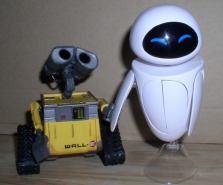Building a Display, Part 1

So. Now you're the proud owner of a collection of action figures, toy cars, dolls, or whatever it is that interests you.
Now what?
Once you have the toys, you obviously need to put them somewhere, and stuffing them in a cardboard box would be a shame. No, you're going to want to put them on display, show them off to the world - or, at the very least, your startled guests.
So, how do you do it? How do you turn your living room into a pop-culture museum?
That's the question I'm going to try and help you answer in a set of articles dedicated to the art of toy display.
Before we get started, I feel the need to put in a disclaimer or two. First off, I don't have a background as an artist, set director, or anything of the sort. The only displays I put together while working retail were dictated by planogram or the whims of a manager. What's that mean? Simple: I have no qualifications whatsoever for offering advice on this subject beyond the pictures you see around here.
While I don't have a background doing this professionally, I do have some experience. But if you glance at my pictures and think the layout is awful, you'll probably want to seek advice elsewhere.
Further, there are two factors that don't apply to me: pets and children. Obviously, if you have a cat, a puppy, or young ones running around your home, your first priority has to be ensuring a SAFE ENVIRONMENT. I don't have any useful advice for those of you in that predicament, save taking extra care that everything is stabilized.
Line Display

To my way of thinking, there are three basic kinds of displays. In the first, toys are arranged in a fairly direct manner; stacked or lined up to utilize space and keep things simple. These displays tend to be fairly straight forward and work well on shelves. To pull this off, you'll generally want to have figures in the same scale. Really, this works best if you have a set of toys from the same line or that are thematically related and of a similar size (for example, a collection of twelve inch zombies would look good together).
While these displays may be a little less dynamic then some of the others, they're generally neater and more likely to suggest that you're a collector (rather than someone who plays with toys).
Keep in mind that just because toys are lined up doesn't mean you need to keep everything on the same level. Using levels or layers can save space while creating a better display.
If you're working with action figures, the biggest problem you'll have is getting them to stand. While some figures stand up straight, others require some posing to find their center of balance. Because you're going to want them in similar positions, that's going to create some problems. If you have the option, you can shift their center of balance backward and lean them against a wall. This obviously works best with narrow shelves. Otherwise, you might need to use bases. If the figures you're displaying came with bases, you can use those. If not, see if you have any extra bases lying around.
|
If you find yourself base-less, don't despair: you can buy or even make bases for many figures. I also utilize wire, from time to time, to create an invisible back wall for characters to lean against. |
The Diorama
While it doesn't work for every situation, my favorite type of display is the diorama. This works best for figures from the same or similar lines, though you have a little leeway (6 inch figures will work with 7 inch figures, for instance, though it's less than ideal). Over the past six months, I've reviewed a lot of DC Universe Classics figures. Lets take a look at some of those figures again, this time on the shelf:
|
There are a few tricks to making this kind of display work. First, try for a variety of poses. Unlike the statuesque technique described above, here you want to imply movement and action. Whenever possible, try to choose poses that represent the character and play on the figure's strengths. |
|
Before moving on I want to add that this style of display doesn't necessarily require a large number of figures. The same theory applies to just two. Take a look at Wall-E and Eve. It isn't complicated, but it is effective. |
The Montage

The third type of display is something of a montage, which combines different figures or characters together similar to the way you'd create a collage. This is useful for combining figures of different scales, types, styles... whatever. I usually like to group figures thematically, like in this 'SF' display I'm putting together.
Now, let's be honest: this isn't as attractive as the other two methods. But, if you've got large shelves and lots of toys, it's better than nothing. A lot a new collectors find themselves setting up a single toy shelf, and that certainly fits into this category. It's not ideal, but it works.
In some ways, this is almost the "default" option if you can't get the other two suggestions to work. That doesn't mean it can't look good, though. Remember to work in three-dimensions and incorporate elements from the other types of displays. Let the toys stand out and create the impression of motion when appropriate.
Those are the three basic types of displays. Next time we're going to be taking a look at using wire to keep figures standing and make them soar.




